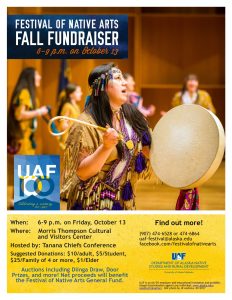The piece below, written by DANSRD Associate Professor Cathy Brooks, reflects on what she learned participating in the ANCSA Impact Series, culminating in a series of panel discussions and presentations hosted by the UAF Department of Alaska Native Studies and Rural Development (DANSRD) and collectively titled “The Impact of the Alaska Native Claims Settlement Act (ANCSA) on Alaska 1971-2011.” The event was held in the Wood Center Ballroom on the UAF campus on October 5 and 6, 2011, in observation of the 40th anniversary of the passage of the act. Recordings of that event, totaling more than 10 hours, are now available online through the UAF Elmer E. Rasmuson Library’s Alaska and Polar Regions Collections & Archives digital repository (https://bit.ly/31SYIRz). Early in 2022, DVDs of these videos will also be available for checkout through the library. For more information, please contact the archives at UAF-APR-reference-Service@alaska.edu
Reflections on the ANCSA Impact Series
Catherine Brooks, Associate Professor, Department of Alaska Native Studies and Rural Development
During the summer and fall of 2011, a series of public lectures and presentations were coordinated by the Department of Alaska Native Studies and Rural Development (DANSRD) in conjunction with the Office of the Chancellor, UA Office of Academic Affairs, and the College of Rural and Community Development, called “The Impact of the Alaska Native Claims Settlement Act (ANCSA) Series.”1
The Impact of ANCSA Series events included a summer lecture, “The Children of ANCSA: A discussion with Willie and Elizabeth Hensley,” a September lecture, “Byron Mallot Shares Reflections,” and a two-day event held in October 2011 featuring numerous speakers from across Alaska. At the time, I was one of the people in the department assisting with the event. The event was the brainstorm of Miranda Wright, who served as the director of DANSRD at the time. Miranda understood the importance of ANCSA and had lived the changes it had brought. She chose a reflections format with the idea there was a lot of information and a lot of directions one could go on addressing the topic. The reflections allowed for a telling of history using personal stories about what the time was like, why they did some of the things they did, and how things had changed in the forty years since passage.
Ironically, it has only been in my own reflection that I realize how impactful the series was on me. The event helped me appreciate the issues and the people involved. Most of the Alaska Natives involved were doing the best they could for the land, people, and culture they loved.
In Willie Hensley’s lecture, he credited his Inupiat upbringing to being able to persevere through the battle for the land. He learned, “you can’t afford to quit; if you quit here, you die.”2 He also shared how in completing the research for one of his college courses, he “owned the understanding”3 of the issue. His understanding of the lands issue helped create the call that Alaska Natives needed to do something. In Byron Mallot’s talk, he emphasized how the initial battle was “not about economics, but about the land, land that needs to be taken care of for future generations.”4 Mallot also spoke of how his mother emphasized it was going to need to be his generation, not hers that made a difference, as “she did not fit” in that world.
The panel discussions focused on history, economics, environment, women, social change, governance, education, and leadership. The numerous stories and sharing in the reflections are full of insights that can help us understand today even better. Many of the individuals that participated in the panels have passed on and I feel fortunate to have heard their stories and sharing. I was shuffling back through my notes on the event (yes, I still have them ten years later) and found myself looking for themes. Although many did not use the word, I would say that resilience and working together definitely emerged as themes. I wish I had written down who said it, but in the margin of my notes, I had, “If you want to know, go out and seek.”
__________________________
- Department of Alaska Native Studies and Rural Development, The Impact of Alaska Native Claims Settlement Act on Alaska 1971-2011, 2011, Fairbanks, AK: Yahdii Media, 2011. DVD
- Hensley, Willie, and Elizabeth Hensley. “The Children of ANCSA: A discussion with Willie and Elizabeth Hensley,” Lecture, Impact of ANCSA Series, Fairbanks, AK, July 7, 2011.
- Hensley, “Children.”
- Mallott, Byron. “Byron Mallott Shares Reflections.” Lecture, Impact of ANCSA Series, Fairbanks, AK, September 13, 2011.


